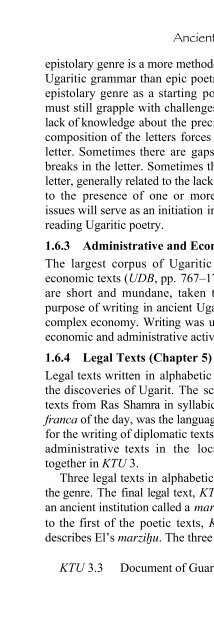A Primer on Ugaritic: Language, Culture, and Literature - enenuru
A Primer on Ugaritic: Language, Culture, and Literature - enenuru
A Primer on Ugaritic: Language, Culture, and Literature - enenuru
Create successful ePaper yourself
Turn your PDF publications into a flip-book with our unique Google optimized e-Paper software.
Ancient Ugarit 23<br />
epistolary genre is a more methodologically sound place to describe<br />
<strong>Ugaritic</strong> grammar than epic poetry. Despite the advantages of the<br />
epistolary genre as a starting point for <strong>Ugaritic</strong> study, students<br />
must still grapple with challenges in these texts. For example, our<br />
lack of knowledge about the precise circumstances surrounding the<br />
compositi<strong>on</strong> of the letters forces us to imagine the occasi<strong>on</strong> of the<br />
letter. Sometimes there are gaps in informati<strong>on</strong> due to physical<br />
breaks in the letter. Sometimes there are c<strong>on</strong>ceptual breaks in the<br />
letter, generally related to the lack of knowledge of a c<strong>on</strong>text <strong>and</strong>/or<br />
to the presence of <strong>on</strong>e or more ambiguous words. These small<br />
issues will serve as an initiati<strong>on</strong> into the more difficult problems in<br />
reading <strong>Ugaritic</strong> poetry.<br />
1.6.3 Administrative <strong>and</strong> Ec<strong>on</strong>omic Texts (Chapter 4)<br />
The largest corpus of <strong>Ugaritic</strong> texts is the administrative <strong>and</strong><br />
ec<strong>on</strong>omic texts (UDB, pp. 767–1775). Although many of the texts<br />
are short <strong>and</strong> mundane, taken together they point to a central<br />
purpose of writing in ancient Ugarit, namely, the maintenance of a<br />
complex ec<strong>on</strong>omy. Writing was used primarily to store data about<br />
ec<strong>on</strong>omic <strong>and</strong> administrative activites.<br />
1.6.4 Legal Texts (Chapter 5)<br />
Legal texts written in alphabetic cuneiform are uncomm<strong>on</strong> am<strong>on</strong>g<br />
the discoveries of Ugarit. The scribes wrote the majority of legal<br />
texts from Ras Shamra in syllabic cuneiform. Akkadian, the lingua<br />
franca of the day, was the language of legalese in Ugarit, especially<br />
for the writing of diplomatic texts. Scribes chose to write <strong>on</strong>ly local<br />
administrative texts in the local language. These are grouped<br />
together in KTU 3.<br />
Three legal texts in alphabetic cuneiform introduce students to<br />
the genre. The final legal text, KTU 3.9, details the organizati<strong>on</strong> of<br />
an ancient instituti<strong>on</strong> called a marzih˙u. This text forms a transiti<strong>on</strong><br />
to the first of the poetic texts, KTU 1.114 (exercise §6.1), which<br />
describes El’s marzih˙u. The three documents are<br />
KTU 3.3 Document of Guarantee


